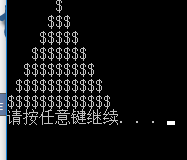part2:

#ifndef GRAPH_H #define GRAPH_H // 类Graph的声明 class Graph { public: Graph(char ch, int n); // 带有参数的构造函数 void draw(); // 绘制图形 private: char symbol; int size; }; #endif

// 类graph的实现 #include "graph.h" #include <iostream> using namespace std; // 带参数的构造函数的实现 Graph::Graph(char ch, int n): symbol(ch), size(n) { } // 成员函数draw()的实现 // 功能:绘制size行,显示字符为symbol的指定图形样式 void Graph::draw() { int i, j, k; for (i = 1; i <= size; i++) { for (j = 1; j <= size - i; j++)cout<<" "; for (k = 1; k <= 2 * i - 1; k++)cout << symbol; cout << endl; } }

#include <iostream> #include "graph.h" using namespace std; int main() { Graph graph1('*',5); graph1.draw(); system("pause"); system("cls"); Graph graph2('$',7); graph2.draw(); system("pause"); return 0; }
截图


part3:

#ifndef FRACTION_H #define FRACTION_H //声名类 class fraction { public: fraction(int a=0, int b=1); void add(fraction x, fraction y); void min(fraction x, fraction y); void mul(fraction x, fraction y); void div(fraction x, fraction y); void com(fraction x, fraction y); void show(); private: int top; int bottom; }; #endif

#include "fraction.h" #include <iostream> using namespace std; fraction::fraction(int a, int b) :top(a), bottom(b) { } //加 void fraction::add(fraction x, fraction y) { int t, r, a, b; top = x.top *y.bottom + y.top*x.bottom; bottom = x.bottom*y.bottom; if (top < bottom) { t = top; top = bottom; bottom = t; } a = top; b = bottom; r = top % bottom; while (r != 0) { top = bottom; bottom = r; r = top % bottom; } top = a / bottom; bottom = b / bottom; } //减 void fraction::min(fraction x, fraction y) { int t, r, a, b; top = x.top *y.bottom - y.top*x.bottom; bottom = x.bottom*y.bottom; a = top; b = bottom; if (top < bottom) { t = top; top = bottom; bottom = t; } r = top % bottom; while (r != 0) { top = bottom; bottom = r; r = top % bottom; } top = a / bottom; bottom = b / bottom; } //乘 void fraction::mul(fraction x, fraction y) { int t, r, a, b; top = x.top *y.top; bottom = x.bottom*y.bottom; a = top; b = bottom; if (top < bottom) { t = top; top = bottom; bottom = t; } r = top % bottom; while (r != 0) { top = bottom; bottom = r; r = top % bottom; } top = a / bottom; bottom = b / bottom; } //除 void fraction::div(fraction x, fraction y) { int t, r, a, b; top = x.top *y.bottom; bottom = x.bottom*y.top; a = top; b = bottom; if (top < bottom) { t = top; top = bottom; bottom = t; } r = top % bottom; while (r != 0) { top = bottom; bottom = r; r = top % bottom; } top = a / bottom; bottom = b / bottom; } //比较 void fraction::com(fraction x, fraction y) { top = x.top*y.bottom; bottom = y.top*y.bottom; if (top > bottom) cout<<'>'; else cout<<'<'; } //输出 void fraction::show() { if (bottom == 0) cout << "分母不能为零!" << endl; else if (bottom == 1) cout << top << endl; else cout << top << "/" << bottom << endl; }

#include <iostream> #include <cstdlib> #include "fraction.h" using namespace std; int main() { fraction a; cout << "a="; a.show(); fraction b1(3, 4); cout << "b1="; b1.show(); fraction b2(1, 4); cout << "b2="; b2.show(); fraction c(5); cout << "c="; c.show(); fraction c1; c1.add(b1, b2); cout << "b1+b2="; c1.show(); c1.min(b1, b2); cout << "b1-b2="; c1.show(); c1.mul(b1, b2); cout << "b1*b2="; c1.show(); c1.div(b1,b2); cout << "b1/b2="; c1.show(); cout << "b1"; c1.com(b1, b2); cout << "b2"<<endl; system("pause"); return 0; }
截图

